It’s only my second Michelada of the trip and I want to kick myself: Why I haven’t been drinking these all along? The first, sipped atop a mountain outside of Oaxaca, was a revelation: beer, lime juice, Worcestershire, soy, and hot sauce; a dash of tamarind and a few glugs of Clamato, served up with ice in a one-liter cup, rimmed with sea salt and chili powder? Yes, please. To the uninitiated, these elements may seem disparate and even bizarre, but trust me when I say this is a drink where it all comes together, and then some.
This Michelada even surpasses the first. Rodrigo, the hulking barman and proprietor, takes great care in its preparation, and the zesty, cooling satisfaction it delivers is just what I need, as the heat here in the lowlands is no joke. I’m covered in a slick of sticky perspiration, and the air is heavy and unmoving. I can feel it press down on my skin and smother what’s left of the afternoon. All the while, the forest around us hisses and squawks with unseen life.
Rodrigo’s joint, El Mono, is a bare-bones affair consisting of a short wicker bar and a couple of tables with cheap plastic chairs. A tiny hut behind holds his supplies, and a corrugated metal semi-roof, along with parasols above the tables, are all that protect us from the elements.
There are no walls and no windows, and just raw earth underneath. This is as open air as it gets, and everything is covered in grime and the greasy film of tropical rot. But fuckin’ hell: this Michelada is a thing of deep wonder, a magical concoction that strikes me to the core as I sweat my life away in this steam room of a jungle.
I drain the big styrofoam cup, sigh, and ask for one more. Rodrigo nods and disappears into his hovel, while the plaintive groan of a howler monkey grates the trees, ushering in the creeping dark.
When I initially set out on this trip, I wasn’t sure if I would make it to Chiapas, Mexico’s rugged southern state that borders Guatemala. After all, it was really far, and the roads leading into it were said to be narrow, serpentine byways winding up and down mountains and sometimes blocked by agitated locals.
I thought instead that, once I left the city of Oaxaca, I’d just head west, to the famously laid-back beaches on that state's Pacific shores. But I had already been to the beach in Mazatlán, and as much as I enjoy the ocean, I’m just not a lay-around-on-the-hot-sand-all-day kind of guy. Mountains and rivers are more my jam. Also, when I talked to the locals and posed my choice, every single one of them told me to go to Chiapas. So I took their advice and am damned glad I did.
Chiapas is probably most well-known for what kicked off there on New Year’s Day, 1994. Indigenous people, who make up the majority of the region’s population, were done with living under the boot of poverty, racism, corruption, and a federal government that did nothing to advance their interests, so they rose up in armed rebellion.
Known as the Zapatistas (or EZLN) and led by a balaclava-wearing, pipe-smoking professor known as Subcomandante Marcos, they seized control of most of the state and effectively run much of it today, especially in the countryside. I could feel the presence of the Zapatistas most everywhere I traveled in Chiapas, whether through political graffiti spray painted on the sides of buildings, actual banners and signs sporting red stars and the letters EZLN, or in the eyes of the local people, who, while absolutely open and kind, clearly carried the spirit of resistance and took no shit from anyone.
My first stop was the mountain town of San Cristóbal de las Casas, which, after Guanajuato and Oaxaca, completed the trinity of my Mexican colonial gems. San Cristóbal radiated cobblestone charm, bringing to mind a smaller, more hippified version of Oaxaca.
The place had a soft, welcoming feel, and it was cool being in a town where, with the exception of the churches, every single building was just one story high. I’m not sure if this was because of the frequent earthquakes or just to create a certain look, but it resulted in a small-town feel, despite the fact that the place is home to nearly two hundred thousand people.
I stayed at a hostel called Los Camellos (“The Camels”), run by a French couple in their fifties. They had been in Chiapas for fifteen years, and seemed to spend the lion’s share of their time sitting at a table in the courtyard sipping beer and vino while chain smoking cigarettes and spliffs. Their Mexican partner did much of the actual work, but hey, these Frenchies, in true Gallic fashion, knew how to enjoy life.
Southern Mexico sees a good deal of travelers and backpackers, and the French were highly represented. There were also loads of Spanish, which should come as no surprise, and even a good deal of Italians, for whom speaking Spanish is just a small leap from their own tongue. And while there were a lot of Americans in Oaxaca, I ran into very few in Chiapas, which was fine with me.
After a couple of easygoing days, it was time to move on, but here is where things got tricky. My plan was to head to the town of Palenque, which is home to the famous Mayan ruins, but the main road there, Highway 199, was said to be famous for stick ups.
It was evidently so bad that the major bus companies refused to even drive the route, electing instead to take a detour to the north that added many hours to the already long journey. Private tour companies did travel the road though, and not only that, they stop at two of Chiapas’s most famous waterfalls on the way to the ruins. I guess they just viewed getting periodically robbed as a cost of doing business.
I signed up for one of the tours, and at the unholy hour of four, we were off in a minivan, heading onto one of Mexico’s most notorious roads in the pitch black. Now I was the only gringo in the vehicle and determined not to show my nerves, as the Mexicans didn’t seem fazed at all. They were a nice group of folks and our driver only drove like he did half a line of meth (not the usual suicidal speed), and soon I forgot that we were trundling into potentially hostile territory.
This was EZLN land, the very countryside where the rebellion caught fire, and countless signs and placards on the side of the highway reminded us of that fact. More ominous were the burnt-out husks of trucks left to rust on the side of the road. When asked about it by one of my curious van mates, the driver said that there had been roadblocks and the trucks were torched in protest.
He seemed to be very sympathetic towards the Zapatistas (as were most people I met), but somehow I didn’t feel so reassured. These little outfits, however, made this trip most every day, and if things were as sketchy as the guidebook and others made it out to be, these companies surely wouldn’t be risking it. I got the sense that things had been relatively quiet of late.
After a buffet breakfast in the town of Ocosingo with the vanfuls of other visitors making the run, we pressed on through a gorgeous, semi-tropical mountain landscape, and at half-past eight we had arrived at Cascada Agua Azul, the big waterfall that is a centerpiece of travel in Chiapas. We were among the first there that morning, and the series of cascades were in the height of their summer monsoon power, bursting forth with roaring intensity.
This was a wide, if not particularly high set of falls. I was told that in the dry season the water takes on a hue of purer blue (hence the name “Agua Azul”), but this was an impressive movement of water as it was, and after climbing up the series of cascades, I located the big swimming holes, which were perfect pools of deep, cool water, surrounded by rushing white currents. I jumped into the swiftest part and let the power of the water carry me, feeling the river wash away the grime of travel.
The next stop was another waterfall called Misol-Ha (native Ch`ol language for “high falls”), which, as the name suggests, is a high cascade. The selling point of these falls, other than their obvious beauty, is the recess eroded in the rock behind them, allowing visitors to walk and stand directly behind the gushing ropes of the water. The falls pour into a deep pool that forms a kind of small lake, and once again I donned my swim trunks and dove in, awash in the splendor of clear water, with a backdrop that was the stuff of travel company promotion videos.
But the day wasn’t even close to done. This was just the morning introduction. We hadn’t even arrived at Palenque! As we descended out of the highlands and into the steamy flat of the jungle, I felt my insides shift with anticipation. This look at ancient Mexico, so close to the border with Guatemala, was to be the exclamation point on the whole trip.
Palenque is an ancient Mayan city that is to have flourished from 226 BC to 799 AD. It was eventually abandoned and reclaimed by the jungle, effectively hiding it from all but very local eyes until the late 1700’s, when Europeans finally began to take an interest in the site. To date, only about ten percent of the city has been excavated, but the structures are amazing in their detail and craftsmanship, clearly showing us just how advanced Mayan civilization was.
The ruins greet you right out of the gate, an astounding collection of stone buildings rising from the jungle`s grip. The whole place has a mystical, romantic feel, and kind of seductive mystery emanating from the structures themselves, and like the great temples of Angkor, you`re allowed to scurry and climb up a lot of it.
As soon as I entered the complex I knew that I had stepped into somewhere extraordinary; I was so awestruck that I could feel the tears well up in my eyes. The only drawback was the hawkers, who were everywhere, selling their trinkets, including jaguar and monkey calls that they blew every thirty seconds, resulting in a cacophony of artificial screeches and howls that hardly served the serenity that the place calls for.
Still, unlike the touts of Angkor, the Palenque trinket sellers were pretty sedate, at least when it came to the hard sell. They didn’t pester or follow me around demanding a sale. They simply set up their wares along the sides of the paths and half-heartedly hailed as I walked by, if that.
Palenque is more than just a collection of old buildings, however. What really makes it a special place is its natural setting. The verdant, explosive bloom of the jungle rivals the structures themselves; moreover, it complements the crumbling, ashen stones, a kind of white on green color scheme that cannot be anything but pleasant on the eyes. The net effect is a great park in the jungle.
Sure, you can go there to explore and traipse around the ruins, but it’s also a terrific place to sit, read, or just relax. This is especially true if you go in the morning or early afternoon (the tour vans from San Cristóbal hit around two and the park closes at four thirty). Things are much quieter then, which is really how it should be.

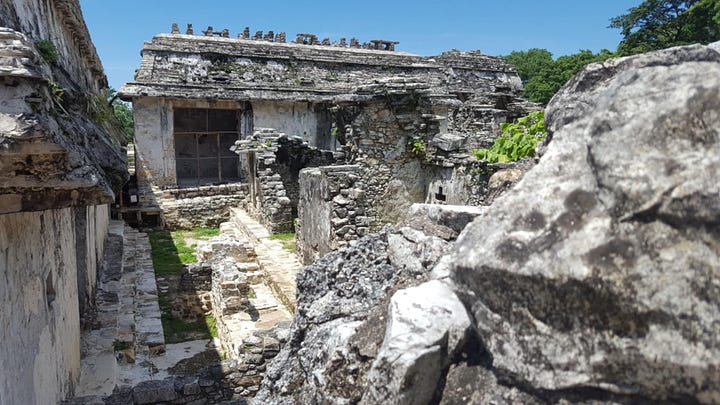


Rather than head back to San Cristóbal like the rest of my unfortunate vanmates, I, on the advice of several folks, elected to stay in Palenque. There are numerous accommodations just outside of the complex, right in the jungle.
I chose a place called El Panchan, which is a cluster of different cabañas and a restaurant and a bar or two built up right amongst the trees and streams that flow through. I got a cheap, second story room with open screen walls and ceiling fan, a perfect jungle bungalow, and called that home for the next two days.
El Panchan was a cool little complex, with a very hippy, `shroomed out feel. That’s probably because most everyone was smoking weed and magic mushrooms were widely available; having blasted through that door of perception many times in my past, I quietly abstained. Chickens and dogs scurried about freely, along with sereques, a kind of a petite, Mexican version of the capybara. Most impressive, and slightly terrifying, however, were the howler monkeys.
I didn’t experience them until my first morning. I had just opened my eyes, when somewhere, in the thick of the trees nearby, I heard what at first sounded like someone dragging metal across pavement. This gave way to a deep, soul scouring gasp, and I soon became aware that it was an animal making this noise, that a cute, furry creature could produce a ghoulish growl that seemed to spring from the deep eye of hell.
The howler monkeys were an extraordinary element in Palenque, lending the place a chilling, wild flavor. What made things even more ominous is that I never actually saw them. I just heard that eerie howl, most often at the witching hours of three or four in the morning. I was told that the monkeys don’t even fight, that the power of the howl itself is enough to scare other males away and establish who gets to be top ape.
On my final day in Chiapas, I decided to get back out in nature for one final session of swimming. I booked a van to the Cascada Roberto Barrio, the third and lesser-known waterfall in the area. Now I was expecting one little falls with a nice pool where you could swim, but was instead greeted by a series of cascades and little lagoons that were the very ideal of tropical paradise.
The pools ranged in size and depth from sit-in-able to probably twenty feet deep. Also, the rocks were covered in a very thin layer of slick, aquatic moss (that made for slipper walking), but this also made it possible to slide off the top and down the stone chutes into the pool below, a kind of natural water slide.
You had to be careful to hit the smooth of the rock in the right place, but it worked splendidly. I did skin my elbow when heading down the biggest chute, but a bit of blood in the water was a small price to pay for the glorious surroundings that I was allowed to fully and freely enjoy.
Chiapas is an off-the-charts wonderland when it comes to waterfalls and swimming holes, equally on par with Laos, and perhaps better. The Cascada Roberto Barrio was the best for an afternoon of pure, unfiltered fun out of the three waterfalls I visited. It was perfect for swimming or just chilling in mouth-agape wonder in front of or behind a waterfall that you had all to yourself. And this was a very real possibility as there were maybe thirty people at the whole site. There was almost no one there, and it was one of the most remarkable spots in nature that I’ve had the pleasure of not just visiting, but of relishing.
Later that night I was sitting in a cheap plastic chair at a cheap plastic table at “Coco Loco,” one of the little jungle bars of El Panchan. It was deadly humid, and I was sipping a Dos Equis with my new friend Juan. Juan was a local indigenous guy who spoke both Ch`ol and Spanish and had an encyclopedic knowledge of the jungle. His eyes shone with natural intelligence and warmth, and he helped me hone my Spanish by gently correcting my (many) mistakes. I in turn taught him a bit of English, and we drank beers and talked life for two nights straight.
“Juan, can I ask you a question?”
“Of course.”
“What do you think of the Zapatistas?”
“I don’t ‘think’ anything of the Zapatistas. I am a Zapatista.”
“I see.”
“This is my home. This is our home. And, this is your home. To be a Zapatista is to be free, and now, Chiapas is free. Free for us to live and free for us to enjoy.”
“Well I’ve certainly done that.”
“And you are welcome to it. Because we are Zapatistas. All of us. And I mean all of us. That means you, too, are a Zapatista.”



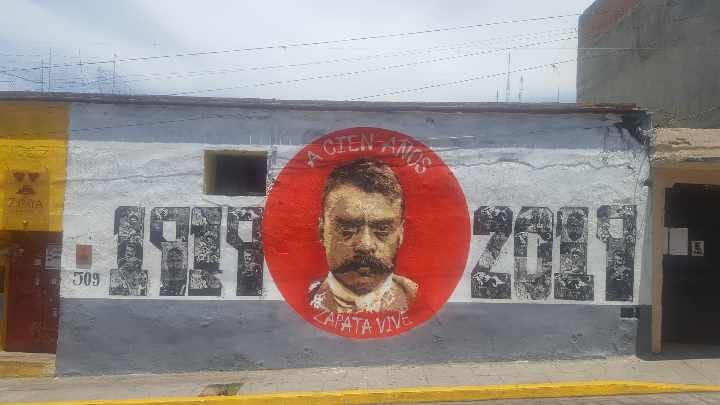
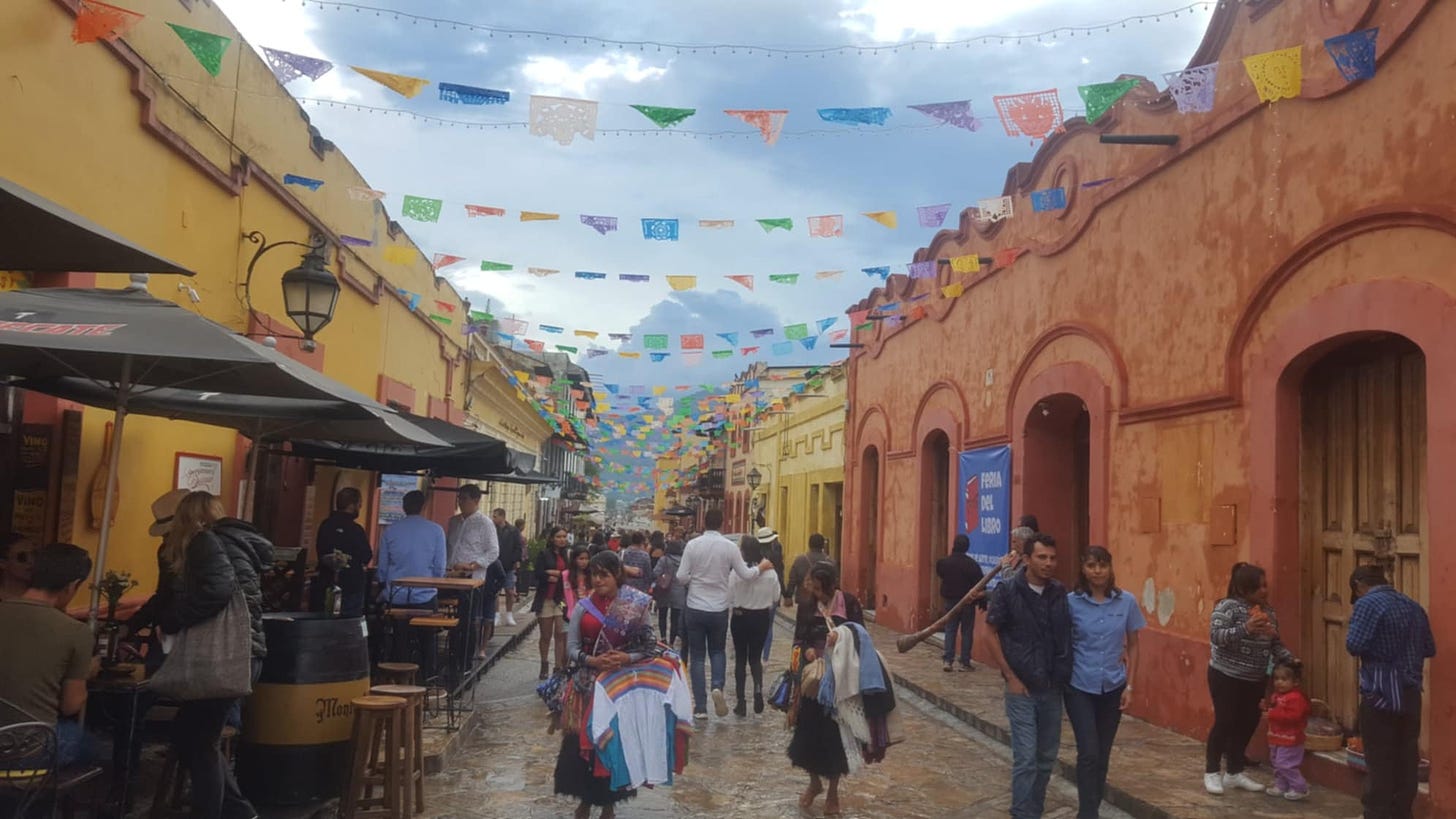
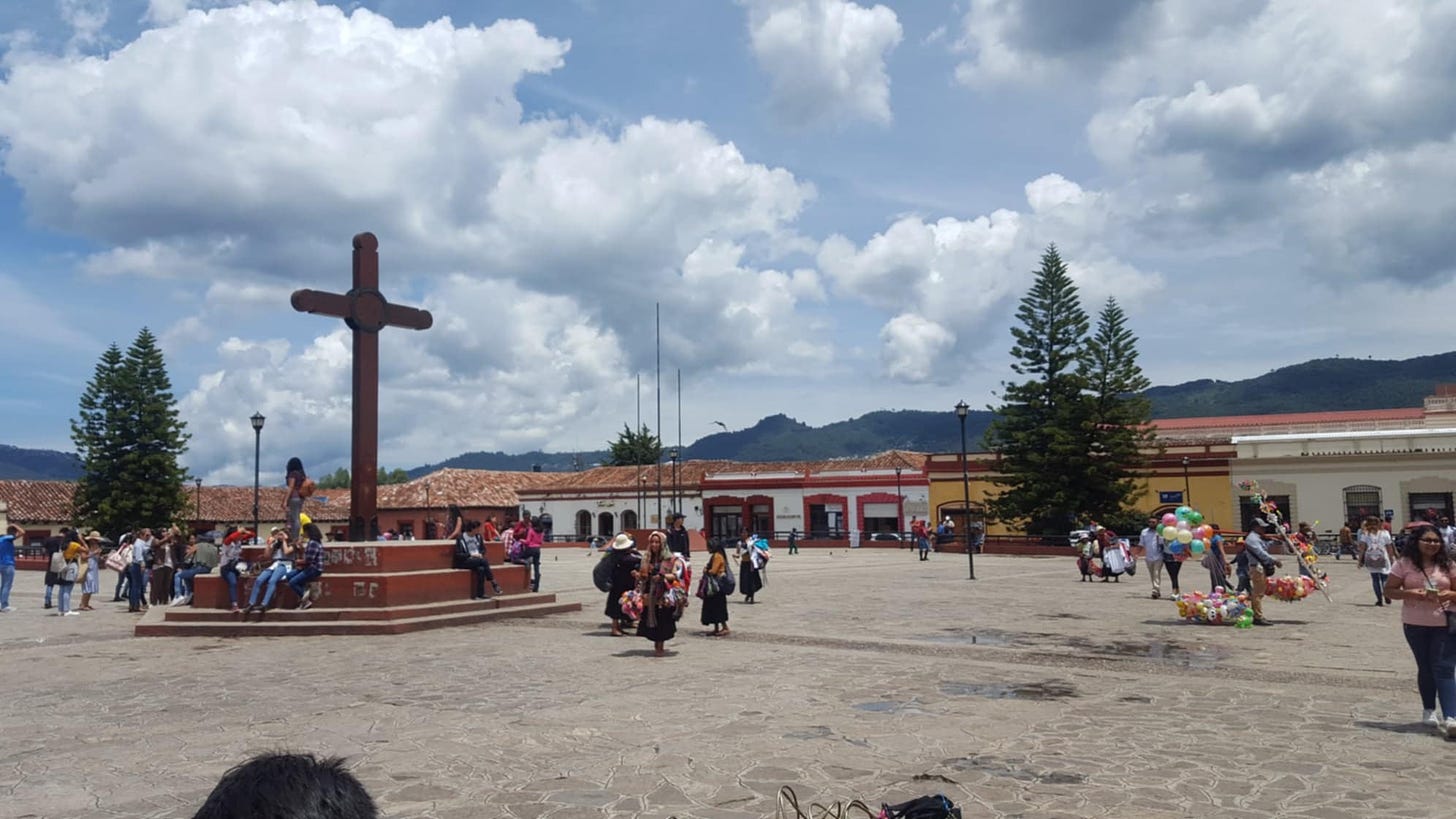

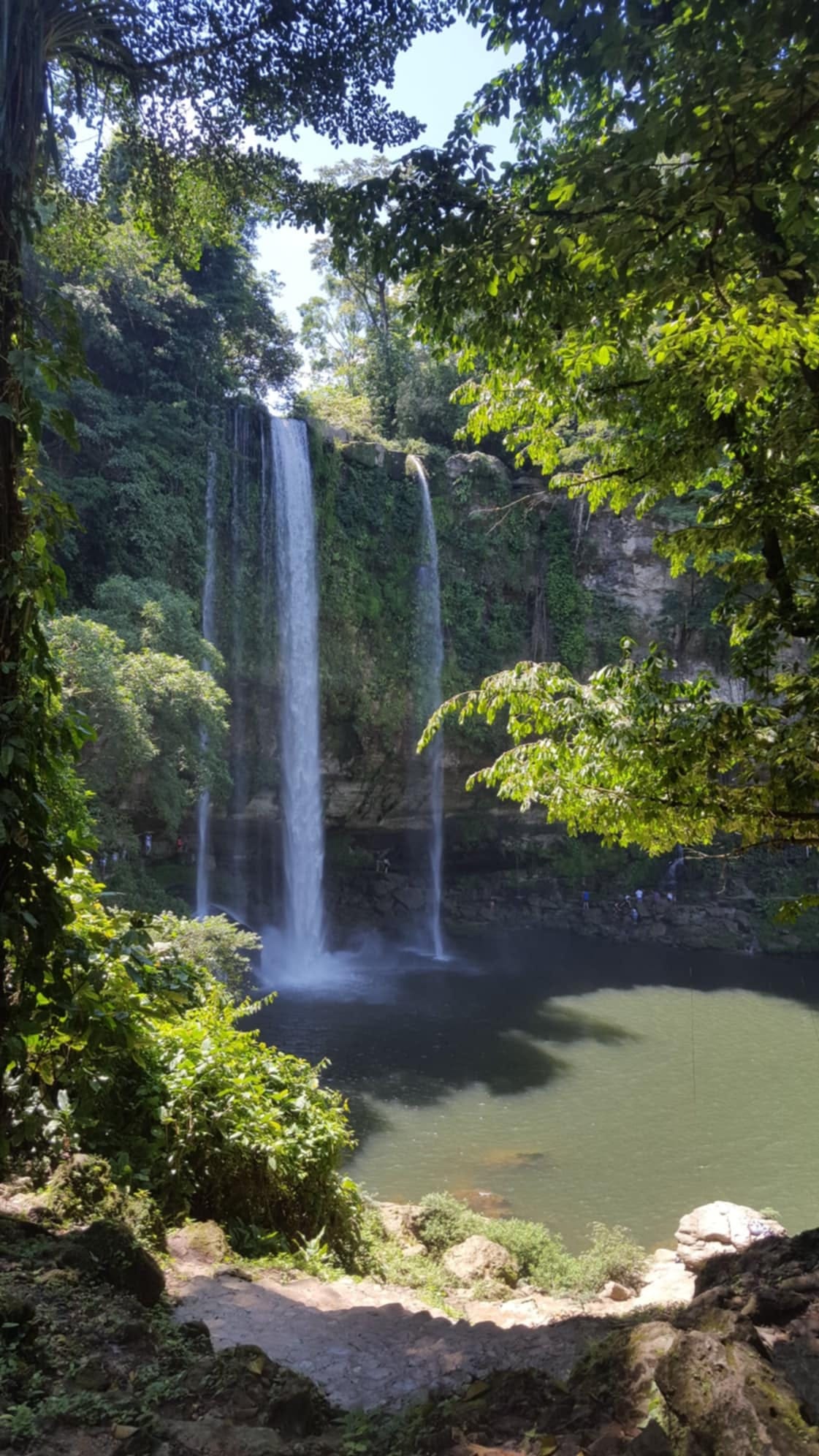
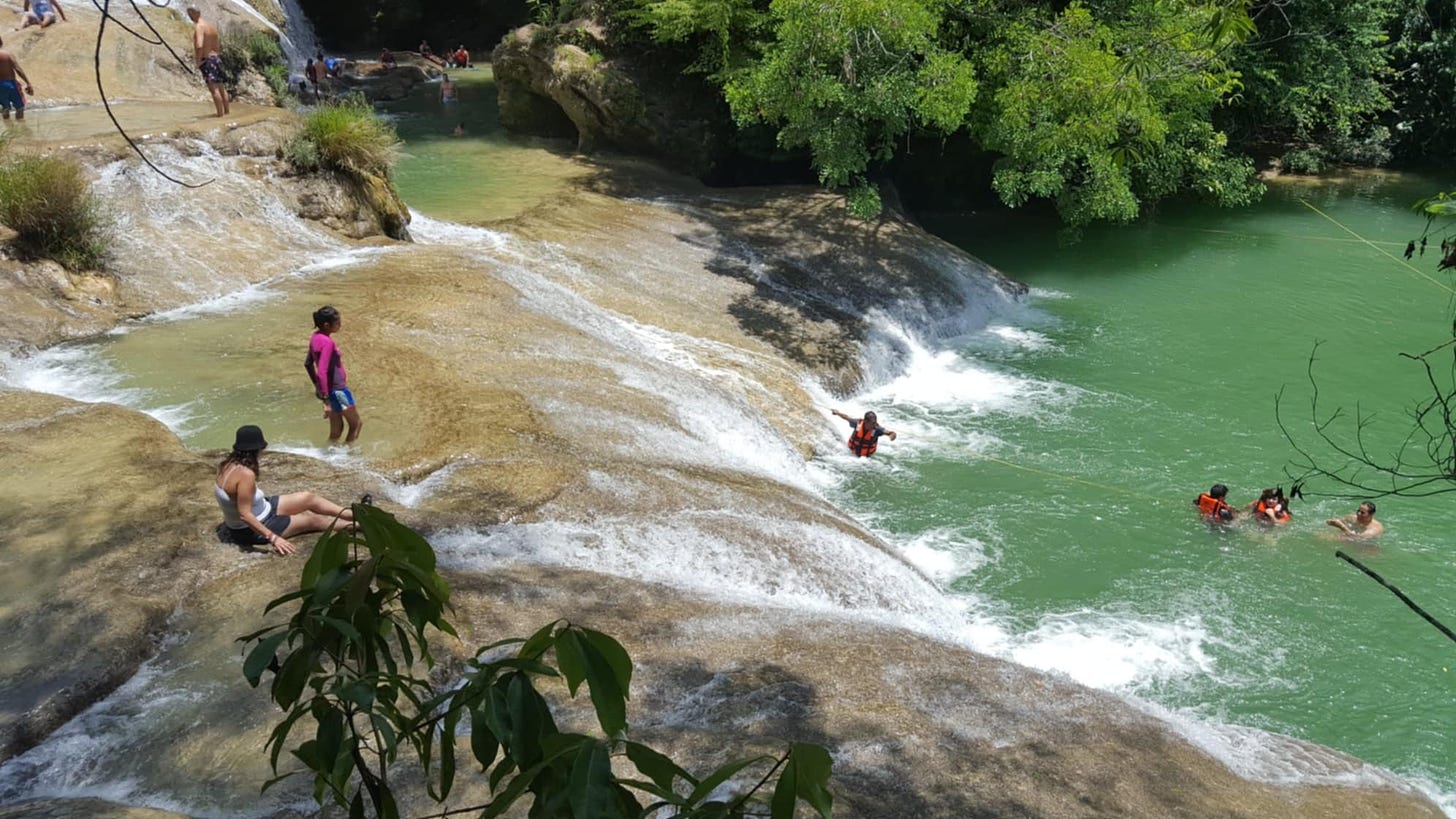
HORARIO DE LA CANTINA FELICES Y GRACIAS
FELICES CANTINA HOURS PART 6